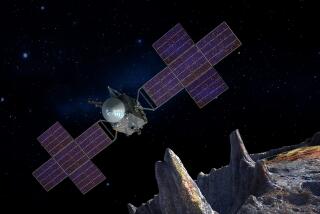For Mercury Probe, the Future Looks Very, Very Bright
NASAâs Messenger spacecraft is scheduled to launch Sunday on a 5-billion-mile trip to Mercury -- the first visit in 30 years to the most extreme and least studied of the inner planets.
It will take seven years for the $427-million probe to reach Mercury, the closest planet to the sun. The probe will orbit the planet for one year, taking color pictures of the entire surface, as well as gathering data on the composition and structure of the crust, the shape and strength of the magnetic field, the makeup of the core and the nature of the material in the polar craters.
Mercury is surprisingly different from the other rocky planets -- Venus, Earth and Mars. The planet is made mostly of iron, making it the densest for its size in the solar system.
It has a magnetic field, even though scientists say such a diminutive planet -- only Pluto is smaller -- should not be able to maintain one. And it may have some water ice hiding in the perpetual shadows of the polar craters -- despite temperatures as high as 850 degrees in the sun.
âItâs a pretty bizarre place,â said Sean Solomon, Messengerâs principal investigator from the Carnegie Institution in Washington.
Scientists are hoping that the planetâs strangeness will illuminate fundamental questions about the formation of the early solar system.
âWhat weâre really chasing is the processes that led to the formation of Venus and Mars and the Earth, and why they produced such different outcomes,â he said.
Mercury was last visited by Mariner 10, which swung by three times in 1974 and 1975, and glimpsed barely half of the planetâs wrinkled surface.
Messenger, managed by the Johns Hopkins University Applied Physics Laboratory in Laurel, Md., will launch from Cape Canaveral Air Force Station in Florida.
For protection from the sun, which will be shining up to 11 times brighter than on Earth, the 1.2-ton spacecraft is constructed of heat-resistant carbon-fiber material and shielded by a ceramic cloth.
The cloth is such a good insulator that the front can be 700 degrees and the back will be room temperature, said Robert Gold, the missionâs payload manager.
With all the solar energy bombarding the craft, one might think that powering it would be simple. But too much power is also a problem, Gold said. The solar panels must tilt so that they are almost edge-on to the sun to avoid frying in the radiation, and even then they are mirrored to help reflect excess energy.
The biggest challenge is achieving a stable orbit around Mercury. In the 1970s, Mariner engineers thought it was impossible.
The spacecraft, they thought, would fall in toward the sun much too quickly to be caught in Mercuryâs small gravity. At the time, there was no way for a spacecraft to carry enough fuel to brake sufficiently.
A Mercury orbiter became feasible in the 1980s when Chen-Wan Yen of the Jet Propulsion Laboratory in Pasadena discovered a complex flight path that uses gravity from three planets to slow the spacecraft down, passing by Earth once, Venus twice and Mercury three times.
Even so, more than half of Messengerâs weight is fuel -- almost all for the final entry into orbit, when the craft must slow down by more than 5,000 mph. It will settle into an elongated oval orbit, passing as close as 124 miles over the surface, and as far away as 9,400 miles.
Humans have known that the planet exists for as long as civilizations have studied astronomy, Solomon said. But we know so little about it because it is extremely difficult to look at objects that close to the sun, even with modern telescopes.
In fact, the planet is one of the few objects in the sky that the Hubble Space Telescope is barred from viewing for fear of damaging the sensitive instruments on board, he added.
Messenger carries seven scientific instruments inside its refrigerator-sized body, including dual color cameras, a laser altimeter to map the three-dimensional surface structure, a magnetometer to characterize Mercuryâs magnetic field and spectrometers to measure gamma rays, ultraviolet and infrared light, X-rays, neutrons and energetic particles.
The instruments and control systems total 110 pounds. The bulk of the spacecraftâs weight -- about 1,300 pounds -- is fuel.
One of the mysteries scientists hope to solve is how Mercury came to be so dense -- its iron core takes up 60% of the planetâs volume, twice as much as Earthâs core.
Solomon offers three possible explanations. Mercury might have always been this dense if the primordial cloud of gas and dust that formed all the planets had more metals closer to the sun. Or the planet might once have been less dense, but solar radiation might have vaporized its crust, leaving only the dense metallic core. Or the crust might have blown away in a collision.
Each theory predicts a different composition of the remaining crust, which Messengerâs spectrometers will measure.
Scientists also hope to determine how such a small planet can maintain a magnetic field.
It is possible that Mercuryâs magnetism is generated in the same way as Earthâs, by a conductive liquid core flowing inside the planet. But many scientists think the core should have solidified by now. They contend that the magnetic field is a âfossil fieldâ left over from when Mercury had a liquid core.
Messengerâs laser altimeter will reveal subtle differences in how fast Mercury spins that will show whether the core is solid or liquid -- just as spinning an egg reveals whether it is raw or hard-boiled.
Of the inner planets, only Earth and Mercury have magnetic fields. Mercuryâs field is about 100 times weaker than Earthâs.
Scientists want to understand how magnetic fields form and what keeps them going on both planets.
âOur magnetic field on Earth has been key to survival of life,â Gold said, because it protects us from harmful solar radiation.





